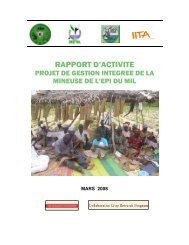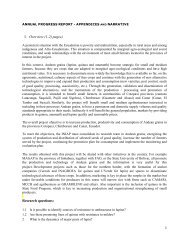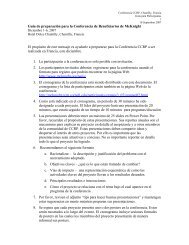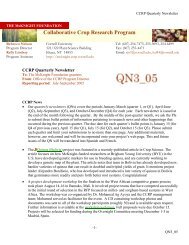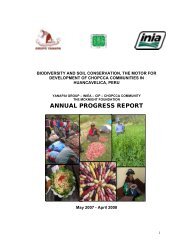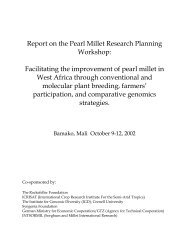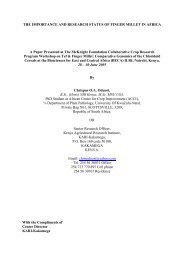English - McKnight Foundation Collaborative Crop Research Program
English - McKnight Foundation Collaborative Crop Research Program
English - McKnight Foundation Collaborative Crop Research Program
You also want an ePaper? Increase the reach of your titles
YUMPU automatically turns print PDFs into web optimized ePapers that Google loves.
<strong>McKnight</strong> <strong>Foundation</strong> <strong>Collaborative</strong> <strong>Crop</strong>s <strong>Research</strong> Project No: 06-741<br />
Introduction:<br />
Cowpea (Vigna unguiculata) is a crop of major importance to the nutrition of poor rural households in<br />
the drier and sub-humid region of Southern Africa, where diets tend to be overly reliant on starchy foods<br />
such as millet, sorghum, maize and cassava. The addition of even a small amount of cowpea ensures the<br />
nutritional balance of the diet and enhances the protein quality by the synergistic effect of high protein<br />
and high lysine from cowpea and high methionine and high energy from cereals. Hence cowpea grain is<br />
an inexpensive, high quality source of protein and its vitamin-rich leaves are eaten as spinach. Women<br />
particularly value cowpeas, which help them to bridge the "hunger months" prior to the main cereal<br />
harvest also it adds cash to the household after selling the grain and dried leaves. It has to be noted that<br />
cowpea is mainly a women crop.<br />
On-farm cowpea yields are extremely low, averaging 319 kg/ha in Tanzania and 388 kg/ha in Malawi.<br />
Use of late maturing cultivars, low plant density and insect damage are widely recognized as important<br />
constraints to improved cowpea production under on-farm conditions. Less well appreciated is the<br />
importance of the parasitic weed Alectra vogelii, which attaches itself to the roots of cowpea plants and<br />
interferes with the plants' ability to obtain water and nutrients. Recently-released improved cowpea<br />
cultivars that are earlier maturing and more tolerant to key insect pests and diseases are especially<br />
susceptible to Alectra attack, experiencing up to 50% yield reductions. A. vogelii is widespread from the<br />
Northern Province of South Africa, through Central Africa to Kenya and across West Africa to Mali. In<br />
Tanzania, A. vogelii is common in Mwanza, Shinyanga, Dodoma, Iringa, Mtwara and Ruvuma regions,<br />
while in Malawi, it is common in Lilongwe, Dowa and districts in central Malawi, the lower lying, drier<br />
areas of the southern region and the Blantyre/Shire Highlands<br />
Project objectives<br />
The general objective of the project is to improve cowpea productivity on A. vogelii-infested land in<br />
Malawi and Tanzania by introducing Alectra resistance into cowpea cultivars that are also early<br />
maturing, pest/disease tolerant and high yielding. The specific objectives are to develop high yielding A.<br />
vogelii resistant cowpea cultivars and then to promote them in both countries, Malawi and Tanzania.<br />
SUMMARY OF RESEARCH ACTIVITIES:<br />
Objective 1: Development of high yielding Alectra vogelii resistant cowpea varieties<br />
In year three of the project further studies have been undertaken to consolidate breeding through transfer<br />
of resistance to Alectra from the resistant lines (donor parents) into the commercial released varieties<br />
(recurrent parents) which are susceptible to Alectra by using a backcross method to improve the<br />
released varieties both in Malawi and Tanzania. Farmers groups established continued to be<br />
strengthened through training and participation in joint activities both within and outside their villages.<br />
Farmers in study villages continued to conduct on farm evaluation of the promising cowpea lines with<br />
commercially released varieties as checks. This year, 10 promising lines in Tanzania and five lines in<br />
Malawi were evaluated by farmers based on their own suitability criterion. In year three, project team<br />
continued to develop partnerships with farmer groups thus allowing continued on farm trials and<br />
availing useful data to research for making informed decisions in on-station breeding programmes.<br />
Through exchange visits and joint design of cowpea breeding programme, research collaboration<br />
between Malawi and Tanzania was increased and capacity was enhanced through farmer group training<br />
and graduate (BSc. and MSc.) students training. Details of activities undertaken on the outputs that the<br />
project had planned to address during the 2008/09 season (year 3) are presented in the individual county<br />
reports in the Annexes. A highlight of this work is as follows<br />
Output 1.1: Producer and consumer preference in cowpea identified<br />
The activities under this output were completed in year 1 and 2 and are found in annual report of 2008.<br />
5<br />
2009



